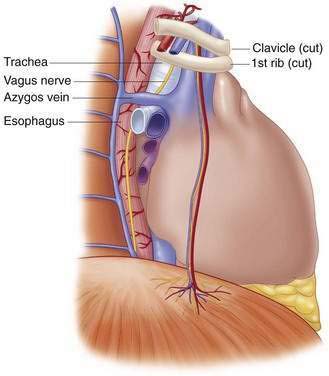CHAPTER 5 Esophageal Atresia with Tracheoesophageal Fistula
Step 1: Surgical Anatomy
♦ The proximal esophagus will be of variable length, and the distal tracheoesophageal fistula (TEF) is usually at or slightly above the carina.
♦ The vagus nerve courses along the trachea, tracheoesophageal groove, and the distal esophagus (Fig. 5-1).
♦ The proximal esophagus receives its blood supply from the thyroid arteries, and the distal esophagus from segmental branches directly off the aorta.
Step 2: Preoperative Considerations
♦ Infants with pure esophageal atresia (EA) will be scaphoid because of absence of gas in the gastrointestinal tract.
♦ Neonates with a TEF may become distended, especially if they are placed on positive pressure ventilation.
♦ A babygram radiograph with a tube in the upper pouch establishes the diagnosis of EA or EA-TEF in a vast majority of neonates (Fig. 5-2). Contrast studies are rarely required.
♦ One must evaluate the baby for the VACTERL complex.
 Cardiac: Echocardiogram to evaluate cardiac anatomy as well as identify position of the aortic arch. Surgical approach through the right or the left side of the chest is determined by the side of the aortic arch. In general, the arch is on the left and access for repair is through the right side of the chest.
Cardiac: Echocardiogram to evaluate cardiac anatomy as well as identify position of the aortic arch. Surgical approach through the right or the left side of the chest is determined by the side of the aortic arch. In general, the arch is on the left and access for repair is through the right side of the chest.
 TE: Plain babygram radiograph with a catheter (bougie or nasogastric [NG]) in upper pouch is sufficient. Many surgeons routinely perform a rigid bronchoscopy as part of the operative procedure before proceeding with the repair to assess for a possible proximal TEF.
TE: Plain babygram radiograph with a catheter (bougie or nasogastric [NG]) in upper pouch is sufficient. Many surgeons routinely perform a rigid bronchoscopy as part of the operative procedure before proceeding with the repair to assess for a possible proximal TEF.
 Cardiac: Echocardiogram to evaluate cardiac anatomy as well as identify position of the aortic arch. Surgical approach through the right or the left side of the chest is determined by the side of the aortic arch. In general, the arch is on the left and access for repair is through the right side of the chest.
Cardiac: Echocardiogram to evaluate cardiac anatomy as well as identify position of the aortic arch. Surgical approach through the right or the left side of the chest is determined by the side of the aortic arch. In general, the arch is on the left and access for repair is through the right side of the chest. TE: Plain babygram radiograph with a catheter (bougie or nasogastric [NG]) in upper pouch is sufficient. Many surgeons routinely perform a rigid bronchoscopy as part of the operative procedure before proceeding with the repair to assess for a possible proximal TEF.
TE: Plain babygram radiograph with a catheter (bougie or nasogastric [NG]) in upper pouch is sufficient. Many surgeons routinely perform a rigid bronchoscopy as part of the operative procedure before proceeding with the repair to assess for a possible proximal TEF.♦ The distance between the two ends of the esophagus can be estimated by placing a blunt tipped bougie (Hurst dilator or small chest tube) into the upper pouch (with mild downward pressure) and taking a chest x-ray; assume that the distal esophagus is at or slightly above the level of the carina. In patients with pure EA who have already had a gastrostomy tube placed, instilling contrast into the stomach during the same maneuver will demonstrate the level of the distal esophagus (Fig. 5-4).















